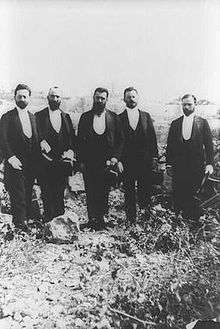Max Bodenheimer

Max Isidor Bodenheimer (Hebrew: מקס בודנהיימר; 12 March 1865 in Stuttgart – 19 July, 1940 in Jerusalem) was a lawyer and one of the main figures in German Zionism. An associate of Theodor Herzl, he was the first president of the Zionist Federation of Germany and one of the founders of the Jewish National Fund.[1] After his flight in 1933 from Nazi Germany, and a short sojourn in Holland, he settled in Palestine in 1935.
Biography
Max Bodenheimer was born on 12 March 1865 in Stuttgart to an assimilated Jewish family. He studied at Tübingen, Strassburg, Berlin and Freiburg universities from 1884 to 1889.
In 1890 he moved to Cologne to start a law practice. In 1891 he published his first Zionist article in the weekly "Die Menorah" (Hamburg). In Cologne he met David Wolffsohn and the two became close friends. Bodenheimer and Wolffsohn participated in various Zionist groups and activities in Cologne and also established a Zionist group named “Zion”. At that time Bodenheimer began correspondence with Theodor Herzl.
In 1896 he married Rosa Dalberg and had three children: Simon Fritz, a professor of zoology at the Hebrew University of Jerusalem, Henrietta Hannah, who wrote a biography of her father, and Ruth, a lawyer.
When Bodenheimer died, the national institutions flew flags at half staff and a eulogy was delivered by Ussishkin, president of the Jewish National Fund.[2]
Zionist activity
Bodenheimer participated at the 1st Zionist Congress and was elected to be a member of the Inner Actions Committee. In 1898 he visited Palestine as a member of the delegation which accompanied Herzl to meet the German Emperor, Wilhelm II. Bodenheimer took part in the Zionist Congresses, helped to write the constitution of the Zionist movement and the Jewish National Fund (JNF), and was the chairman of the Board of Directors of the JNF in Germany. When the First World War broke out, he moved the JNF offices from Cologne to The Hague.
In August 1914, at the outbreak of World War I, he submitted an Exposé on the Synchronization of German and Jewish Interests in the World War to German military headquarters in Cologne. He set out his vision to Count Hutten-Czapski of the General Staff, chief of sabotage operations on the eastern front. With support from the General Staff and the Wilhelmstrasse, he established the German Committee for Freeing of Russian Jews, together with 6 German Zionist colleagues, on 17 August 1914. He resigned his chairmanship of the Jewish National Fund. Bodenheimer wanted the German army to assault the power of the Tsarist empire in the Baltic states, Poland, White Russia and the Ukraine, where he hoped for an 'East European Federation' in which 'all ethnic groups were to enjoy national autonomy', including the Jews, in the Pale of Settlement.[3] It seems like he was the author of the conception of the establishment of the League of East European States - a German client state with autonomous Jewish cooperation.[4]
Like other veterans from the Herzl period, Bodenheimer’s status declined after the First World War, and he was not re-elected as a member of the Board of Directors of the JNF. In August 1929, joins the Revisionist party led by Ze'ev Jabotinsky. Bodenheimer attended the 17th Zionist Congress as a representative of the Revisionist party. During the Congress, a sharp controversy arose between the majority and the Revisionist party concerning the "ultimate goal" of Zionism, and the Revisionists left the Congress. This was the last Zionist Congress in which Bodenheimer participated.
In 1935 Bodenheimer immigrated to Palestine and settled in Jerusalem, where he began writing his memoirs. He died in July 1940.[5]
Writings
- Prelude to Israel. The Memoirs of M. I. Bodenheimer. edited by Henriette Hannah Bodenheimer, New York, London, Thomas Yoseloff, 1963.
- Bodenheimer, Max I. and Bodenheimer, Henriette Hannah, Die Zionisten und das Kaiserliche Deutschland, Bensbert, Schaeube Verlag, 1972.
- M.I. Bodenheimer, So wurde Israel: Aus der Geschichte der zionistischen Bewegung: Erinnerungen (herausgegeben von Henriette Hannah Bodenheimer), Frankfurt a.M.: Europäische Verlagsanstalt, 1958.
- Syrien ein Zufluchtsort der russischen Juden. Hamburg, Verlag des Deutsch-Israelitischen Familienblattes 'Die Menorah', 1891.
References
- ↑ Zionism and Technocracy: The Engineering of Jewish Settlement in Palestine, 1870-1918, Derek Jonathan Pensla
- ↑ Max Bodenheimer, Zionist pioneer, dies in Jerusalem at 75
- ↑ Sean McMeekin, The Berlin-Baghdad Express, pp.344-345
- ↑ "Iwo Cyprian Pogonowski Jews in Poland - New York 1998, p. 297".
- ↑ A biography on Max Bodenheimer
External links
- The Society for the Commemoration of Max I. Bodenheimer and Hannah Henriette Bodenheimer
- The personal papers of Max Bodenheimer are kept at the Central Zionist Archives in Jerusalem. The notation of the record group is A15.